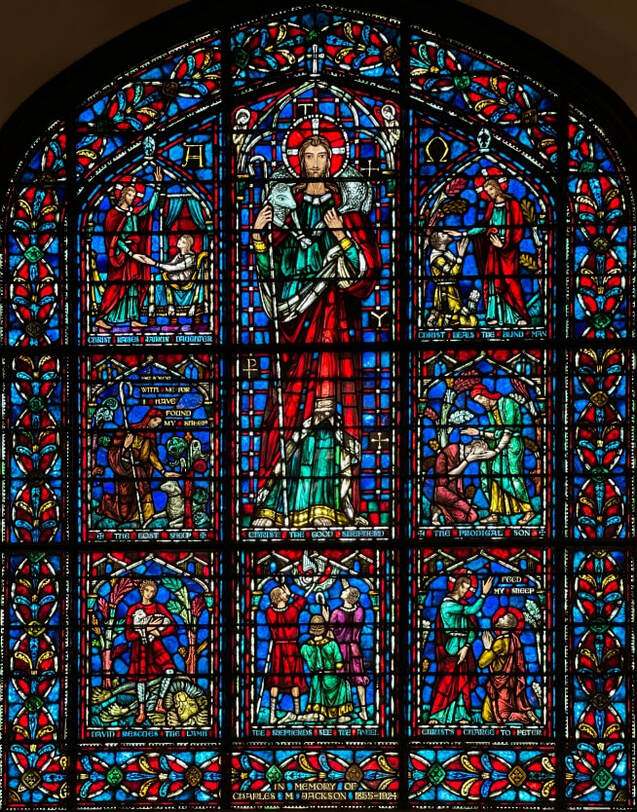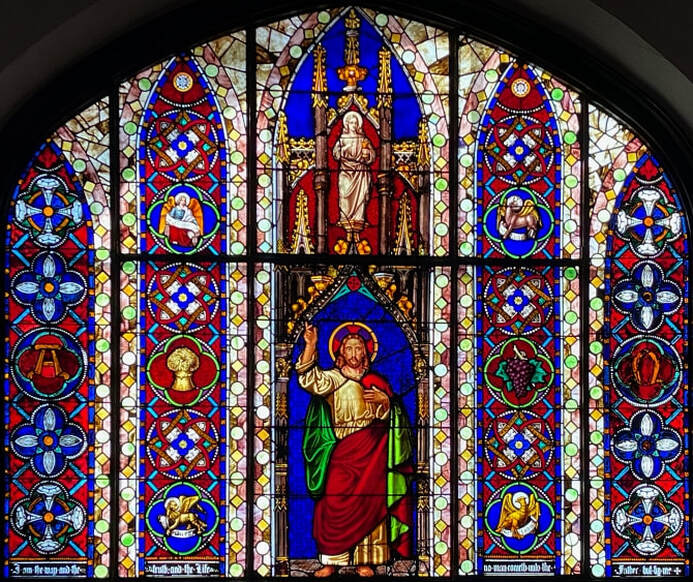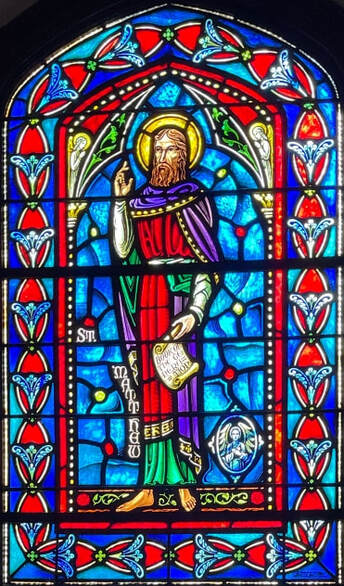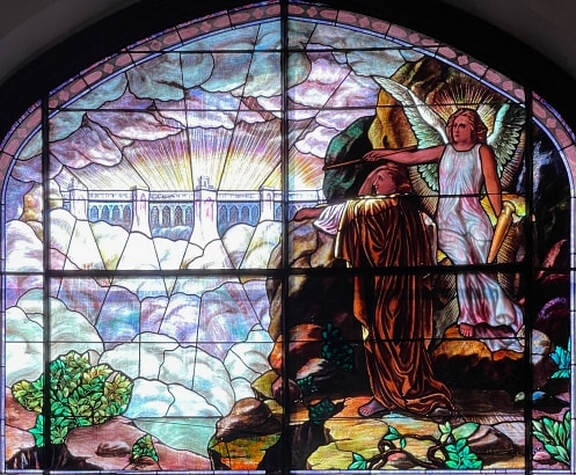St. John's Historic Stained Glass Windows |
Christ the Good Shepherd North Transept, 1925. Made in Boston, this window depicts Christ in the center with a shepherd's crook and the lost sheep on his shoulder. He is surrounded by panels showing the raising of Jarius' daughter, healing the blind man, finding the lost sheep, the prodigal son, David rescuing the lamb, the shepherds seeing the angels proclaiming Jesus' birth, and Christ's charge to Peter to "feed my sheep." The window also contains the Alpha and Omega. |
Christ Proclaiming the Good News (below)
This window is over the West entrance to the church. (El Dorado Street) It was originally over the altar in the first church building, and is therefore our oldest window, dating from 1887. In its original installation, it consisted of five individual lancet windows. You can still discern this by omitting the brown-shaded glass between the panels.
The central figure of Christ is surmounted by an image of St. John the Evangelist. St. John holds a chalice with a snake emerging from it, and his right hand is raised in blessing. This depicts an ancient story of someone attempting to poison John. When he blessed the wine before drinking it, the poison came out of the wine in the form of a snake. St. John was then able to drink the wine with no ill effect.
The panels on either side of Christ show the symbols of the four Evangelists, the Angel for Matthew, the Winged Ox for Luke, the Winged Lion for Mark, and the Eagle for John. The left panel also contains an image of a sheaf of wheat, and the right a clump of grapes. These represent the bread and wine of the Last Supper and Holy Communion.
The far left panel contains the Greek letter Alpha, and the far right panel contains the letter Omega. "I am the Alpha and the Omega, the beginning and the end."
At the bottom of the left two panels are the words "I am the way and the truth and the life." At the bottom of the right two panels are the words "No man cometh unto the Father but by me."
This window is over the West entrance to the church. (El Dorado Street) It was originally over the altar in the first church building, and is therefore our oldest window, dating from 1887. In its original installation, it consisted of five individual lancet windows. You can still discern this by omitting the brown-shaded glass between the panels.
The central figure of Christ is surmounted by an image of St. John the Evangelist. St. John holds a chalice with a snake emerging from it, and his right hand is raised in blessing. This depicts an ancient story of someone attempting to poison John. When he blessed the wine before drinking it, the poison came out of the wine in the form of a snake. St. John was then able to drink the wine with no ill effect.
The panels on either side of Christ show the symbols of the four Evangelists, the Angel for Matthew, the Winged Ox for Luke, the Winged Lion for Mark, and the Eagle for John. The left panel also contains an image of a sheaf of wheat, and the right a clump of grapes. These represent the bread and wine of the Last Supper and Holy Communion.
The far left panel contains the Greek letter Alpha, and the far right panel contains the letter Omega. "I am the Alpha and the Omega, the beginning and the end."
At the bottom of the left two panels are the words "I am the way and the truth and the life." At the bottom of the right two panels are the words "No man cometh unto the Father but by me."
|
St. Matthew, Apostle and Evangelist
South Transept, 1949. The window depicts Matthew bearing the “Book of Generations.” His Evangelist symbol of a winged-man (or angel) is illustrated near his feet, and his right hand is raised in blessing. This window, along with the adjacent St. Andrew window, is adorned with two praying angels. According to early Christian writers, Matthew converted many people to Christianity in Judea, and then traveled on to the East; however, there is no certain evidence of this. He has traditionally been venerated as a martyr, but the time and circumstances of his death are unknown; therefore, there is no symbol of martyrdom to include in art. His feast day is September 21st. |
|
The New Jerusalem
South Transept, 1921. “And I saw the holy city, the new Jerusalem, coming down out of heaven from God, prepared as a bride adorned for her husband.” - Revelation 21:2 This window depicts John the Evangelist seeing in a vision the new Jerusalem. An angel accompanies him and also points to the holy city. The names of the four Evangelists, or authors of the Gospels, are written in Greek on the walls of the new Jerusalem. |
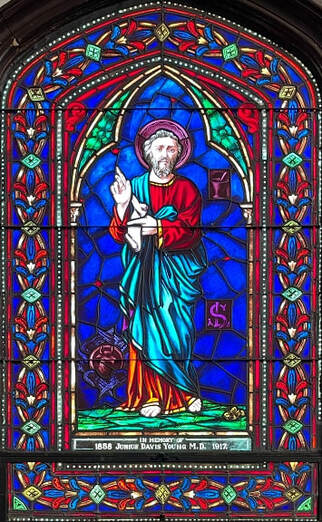
St. Luke, Apostle and Evangelist
South Aisle, 1918.
The winged ox in the lower left, and the mortar and pestle near his shoulder are symbols of Luke, the physician. He authored one of the gospels, and the Acts of the Apostles. He is patron saint of the healing arts. This window was donated, appropriately, in memory of a physician, Dr. Junis Young.
His feast day is October 18th.
South Aisle, 1918.
The winged ox in the lower left, and the mortar and pestle near his shoulder are symbols of Luke, the physician. He authored one of the gospels, and the Acts of the Apostles. He is patron saint of the healing arts. This window was donated, appropriately, in memory of a physician, Dr. Junis Young.
His feast day is October 18th.
